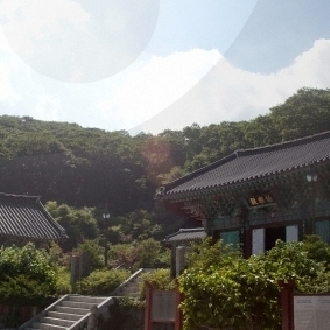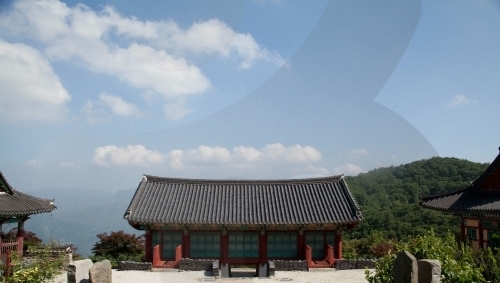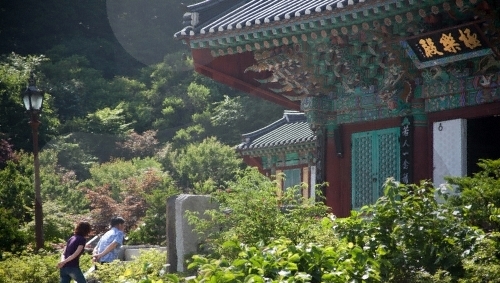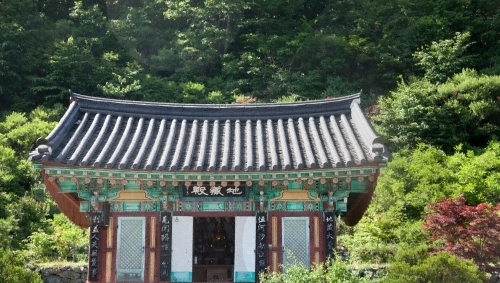Introduction:
Directions [Bus] From Dong Seoul Terminal, take the bus towards Yeongdong. - Take the bus bound for Muju. (travel time 30min) - Take the city bus towards Jeonju. - Get off at Seochang.Information Introduction As the only temple in Jeoksangsan (or Mt. Jeoksang), Anguksa Temple was built in 1227 (during the 3rd year of King Chungryeol’s reign) by Monk Wolin. A secret historical archives, called Sagak, was built to store Joseonwangjo Sillok (annals of the Joseon Dynasty) in 1614 (during the 6th year of King Gwanghaegun’s reign) within the mountain, while Seonukgak was built in 1641 (during the 19th year of King Injo’s reign) to store Seonwonrok (royal genealogical records). The two sites were designated as Jeoksangsan Historical Archives during the Joseon Dynasty. Hoguksa Temple was also built at that time to prevent accidents from affecting the archives. The temple, along with the existing Anguksa Temple, was used to house monk soldiers who protected the archives. Because of the construction of Muju Power Plant, Anguksa Temple was relocated to the Hoguksa Temple site and rebuilt in 1995. Consisting of 15 buildings, the temple is surrounded by Sanjeong Lake. Boasting exquisite fall foliage, the temple can be easily reached by vehicle along a paved road. The nearby attractions include Muju Resort and Muju Gucheondong Valley. Telephone +82-63-322-6162 Closed N/A (Open all year round) Activity Information [Anguksa Templestay] Daily Temple Stay Break time Templestay Anguksa Taekwon Templestay * For more detailed information, please visit its official website and make a phone call. Parking Facilities Available Admission Fees Free Interpretation Services Offered Not available Baby Stroller Rentals Not Available Pets Not Available
Directions [Bus] From Dong Seoul Terminal, take the bus towards Yeongdong. - Take the bus bound for Muju. (travel time 30min) - Take the city bus towards Jeonju. - Get off at Seochang.
Tel:
• 1330 Travel Hotline: +82-2-1330
(Korean, English, Japanese, Chinese)
• For more info: +82-63-322-6162
Information:
As the only temple in Jeoksangsan (or Mt.
Jeoksang), Anguksa Temple was built in 1227 (during the 3rd year of King Chungryeol’s reign) by Monk Wolin.
A secret historical archives, called Sagak, was built to store Joseonwangjo Sillok (annals of the Joseon Dynasty) in 1614 (during the 6th year of King Gwanghaegun’s reign) within the mountain, while Seonukgak was built in 1641 (during the 19th year of King Injo’s reign) to store Seonwonrok (royal genealogical records).
The two sites were designated as Jeoksangsan Historical Archives during the Joseon Dynasty.
Hoguksa Temple was also built at that time to prevent accidents from affecting the archives.
The temple, along with the existing Anguksa Temple, was used to house monk soldiers who protected the archives. Because of the construction of Muju Power Plant, Anguksa Temple was relocated to the Hoguksa Temple site and rebuilt in 1995.
Consisting of 15 buildings, the temple is surrounded by Sanjeong Lake.
Boasting exquisite fall foliage, the temple can be easily reached by vehicle along a paved road.
The nearby attractions include Muju Resort and Muju Gucheondong Valley.
Telephone: +82-63-322-6162 Closed N/A (Open all year round) Activity [Anguksa Templestay] Daily Temple Stay Break time Templestay Anguksa Taekwon Templestay * For more detailed information, please visit its official website and make a phone call.
Parking Facilities Available Admission Fees Free Interpretation Services Offered Not available Baby Stroller Rentals Not Available Pets Not Available
Directions [Bus] From Dong Seoul Terminal, take the bus towards Yeongdong. - Take the bus bound for Muju. (travel time 30min) - Take the city bus towards Jeonju. - Get off at Seochang.Information Introduction As the only temple in Jeoksangsan (or Mt. Jeoksang), Anguksa Temple was built in 1227 (during the 3rd year of King Chungryeol’s reign) by Monk Wolin. A secret historical archives, called Sagak, was built to store Joseonwangjo Sillok (annals of the Joseon Dynasty) in 1614 (during the 6th year of King Gwanghaegun’s reign) within the mountain, while Seonukgak was built in 1641 (during the 19th year of King Injo’s reign) to store Seonwonrok (royal genealogical records). The two sites were designated as Jeoksangsan Historical Archives during the Joseon Dynasty. Hoguksa Temple was also built at that time to prevent accidents from affecting the archives. The temple, along with the existing Anguksa Temple, was used to house monk soldiers who protected the archives. Because of the construction of Muju Power Plant, Anguksa Temple was relocated to the Hoguksa Temple site and rebuilt in 1995. Consisting of 15 buildings, the temple is surrounded by Sanjeong Lake. Boasting exquisite fall foliage, the temple can be easily reached by vehicle along a paved road. The nearby attractions include Muju Resort and Muju Gucheondong Valley. Telephone +82-63-322-6162 Closed N/A (Open all year round) Activity Information [Anguksa Templestay] Daily Temple Stay Break time Templestay Anguksa Taekwon Templestay * For more detailed information, please visit its official website and make a phone call. Parking Facilities Available Admission Fees Free Interpretation Services Offered Not available Baby Stroller Rentals Not Available Pets Not Available
Directions [Bus] From Dong Seoul Terminal, take the bus towards Yeongdong. - Take the bus bound for Muju. (travel time 30min) - Take the city bus towards Jeonju. - Get off at Seochang.
Tel:
• 1330 Travel Hotline: +82-2-1330
(Korean, English, Japanese, Chinese)
• For more info: +82-63-322-6162
Information:
As the only temple in Jeoksangsan (or Mt.
Jeoksang), Anguksa Temple was built in 1227 (during the 3rd year of King Chungryeol’s reign) by Monk Wolin.
A secret historical archives, called Sagak, was built to store Joseonwangjo Sillok (annals of the Joseon Dynasty) in 1614 (during the 6th year of King Gwanghaegun’s reign) within the mountain, while Seonukgak was built in 1641 (during the 19th year of King Injo’s reign) to store Seonwonrok (royal genealogical records).
The two sites were designated as Jeoksangsan Historical Archives during the Joseon Dynasty.
Hoguksa Temple was also built at that time to prevent accidents from affecting the archives.
The temple, along with the existing Anguksa Temple, was used to house monk soldiers who protected the archives. Because of the construction of Muju Power Plant, Anguksa Temple was relocated to the Hoguksa Temple site and rebuilt in 1995.
Consisting of 15 buildings, the temple is surrounded by Sanjeong Lake.
Boasting exquisite fall foliage, the temple can be easily reached by vehicle along a paved road.
The nearby attractions include Muju Resort and Muju Gucheondong Valley.
Telephone: +82-63-322-6162 Closed N/A (Open all year round) Activity [Anguksa Templestay] Daily Temple Stay Break time Templestay Anguksa Taekwon Templestay * For more detailed information, please visit its official website and make a phone call.
Parking Facilities Available Admission Fees Free Interpretation Services Offered Not available Baby Stroller Rentals Not Available Pets Not Available
Top Things to Do in Anguksa Temple

Where is Anguksa Temple
전라북도 무주군 적상면 산성로 1050 (적상면)












Reviews (10)